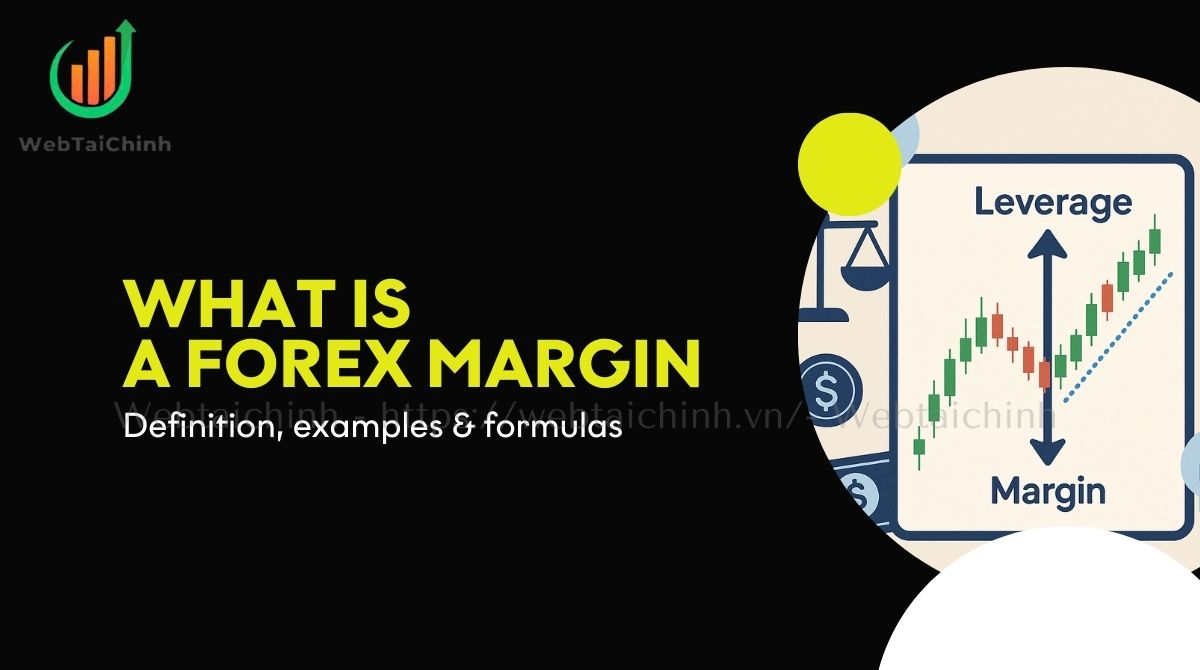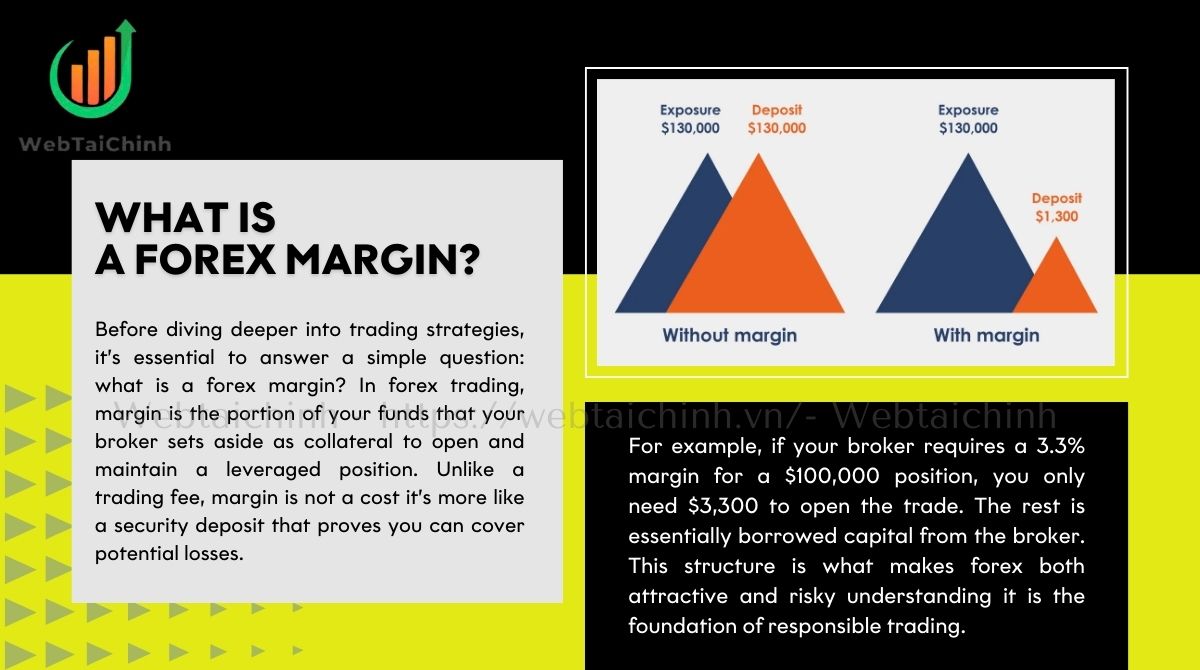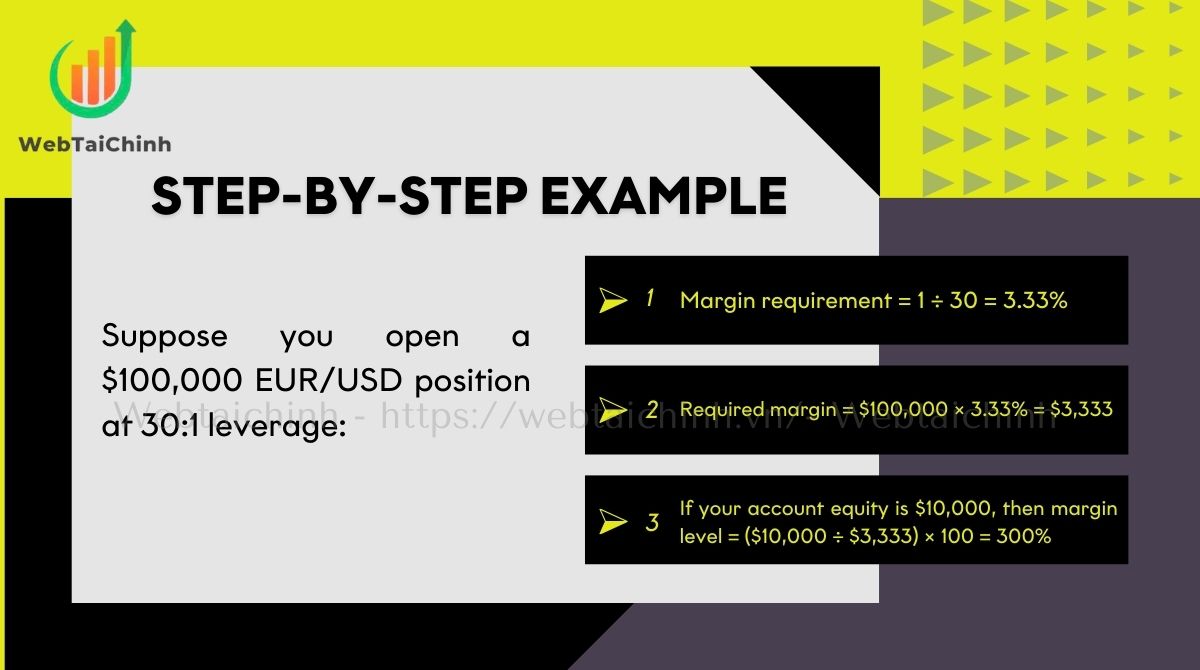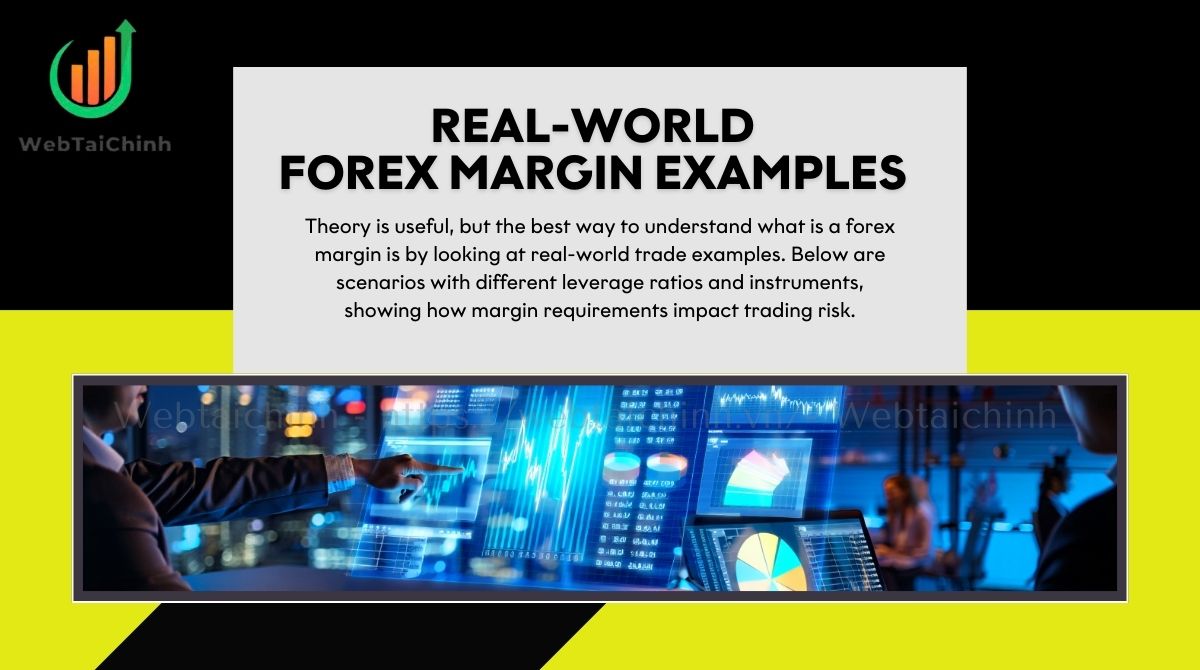Physical Address
304 North Cardinal St.
Dorchester Center, MA 02124
Physical Address
304 North Cardinal St.
Dorchester Center, MA 02124

What is a forex margin and why does it matter for traders? Forex margin is the collateral your broker sets aside to let you control larger trades with less capital. For many traders, this opens the door to higher profit potential but it also increases risk if not managed properly. Without a clear understanding of margin, you risk margin calls, forced liquidations, and rapid account losses.
This guide from Webtaichinh explains forex margin in plain terms, shows you exactly how it works, and provides formulas, examples, and tips to manage risk like a pro.
Key takeaways:
Before diving deeper into trading strategies, it’s essential to answer a simple question: what is a forex margin? In forex trading, margin is the portion of your funds that your broker sets aside as collateral to open and maintain a leveraged position. Unlike a trading fee, margin is not a cost it’s more like a security deposit that proves you can cover potential losses.

Think of margin as the bridge between your trading capital and the much larger positions you want to control. Without it, leverage would not exist. With it, traders gain access to opportunities far beyond their actual balance but also face amplified risks if the market turns against them.
Key characteristics of forex margin include:
For example, if your broker requires a 3.3% margin for a $100,000 position, you only need $3,300 to open the trade. The rest is essentially borrowed capital from the broker. This structure is what makes forex both attractive and risky understanding it is the foundation of responsible trading.
Once you understand what is a forex margin, the next question is why it matters so much in trading. The answer lies in its dual nature: margin can unlock powerful opportunities through leverage, but it also brings significant risks that every trader must respect.
Here’s why forex margin is critical:
Example:
With a 3.3% margin requirement, a $100,000 EUR/USD position only needs $3,300 in collateral. If the market moves in your favor by 1%, you could earn $1,000 profit almost one-third of your margin. But if it moves against you by the same 1%, you could lose $1,000 just as fast. This leverage effect shows why margin management is vital for long-term survival in forex.
Forex margin matters because it determines both the scale of your opportunities and the size of your risks. Traders who treat margin carelessly often face margin calls, while those who manage it strategically gain stability and control.
Besides margin calls, traders also face other risks such as what is considered the greatest risk associated with forex settlement, which highlights the importance of risk management.
To fully grasp what is a forex margin, you need to know how it’s calculated. Forex margin isn’t guesswork it’s based on clear formulas that help traders monitor exposure and avoid costly surprises. Mastering these calculations ensures you can trade with confidence and keep your account safe.
Suppose you open a $100,000 EUR/USD position at 30:1 leverage:

This 300% margin level means you’re comfortably above most broker margin call thresholds (typically 100%).
| Leverage | Margin requirement (%) | Margin needed for $100,000 trade |
|---|---|---|
| 30:1 | 3.33% | $3,333 |
| 50:1 | 2% | $2,000 |
| 100:1 | 1% | $1,000 |
Insight: The higher your leverage, the lower your margin requirement. But with that comes greater volatility in profits and losses making precise margin calculation an essential survival tool.
Remember: Always calculate your required margin before placing a trade. This not only prevents margin calls but also helps you size positions responsibly in line with your risk tolerance.
To fully understand what is a forex margin, traders should know the most important margin-related terms. The table below breaks them down in a simple way:
| Term | Definition | Example |
|---|---|---|
| Margin | Collateral set aside by your broker to open or maintain a trade. Not a fee. | $3,333 margin for a $100,000 trade at 30:1 leverage |
| Margin requirement (%) | Percentage of trade size required as margin. | 2% at 50:1 leverage |
| Used margin | Total margin currently tied up in open positions. | $3,000 used margin from open EUR/USD trade |
| Free margin | Funds left to open new trades = Equity – Used margin. | $7,000 equity – $3,000 used = $4,000 free margin |
| Equity | Balance ± floating profit/loss from open trades. | $10,000 balance + $500 profit = $10,500 equity |
| Balance | Account value excluding open trades. | $10,000 initial deposit |
| Margin level (%) | Ratio of equity to used margin. Formula: (Equity ÷ Used margin) × 100. | (10,000 ÷ 3,000) × 100 = 333% |
| Margin call | Warning when margin level drops below broker’s threshold (e.g., 100%). | Broker asks you to add funds or close trades |
| Stop-out | Forced closure of positions when margin falls below a lower threshold (50–70%). | Broker liquidates losing trades to protect account |
| Maintenance margin | Minimum margin required to keep a position open. | 1% maintenance margin = $1,000 for a $100,000 trade |
| Leverage | Ratio of trade size to margin used. | 100:1 leverage = $1,000 margin for $100,000 trade |
Practical insight: If you have $10,000 equity and $3,000 used margin, your margin level is 333%. But if equity drops to $2,500, margin level falls to 83%, triggering a margin call.
Learning these terms is crucial. Many margin-related losses happen not because traders lack capital, but because they misinterpret free margin, margin level, or broker stop-out rules.
After learning what is a forex margin and the key terms, the next step is applying it to your own trades. Calculating margin is straightforward if you follow a clear process.

Define lot size
Decide how many lots you want to trade. A standard lot is usually 100,000 units of the base currency.
Example: 1 lot of EUR/USD = 100,000 EUR.
Check the price and margin requirement
Confirm the current exchange rate and your broker’s margin requirement.
Example: EUR/USD price = 1.1000, margin requirement = 3.33% (30:1 leverage).
Calculate notional value
Multiply lot size by the current price.
100,000 × 1.1000 = $110,000 notional value.
Find required margin
Multiply notional value by margin requirement.
$110,000 × 3.33% = $3,663 required margin.
Assess margin levels
Compare required margin with your account equity.
If account equity = $5,000, then used margin = $3,663, leaving only $1,337 as free margin.
Add a safety buffer
Aim to keep margin levels above 300% to avoid margin calls or forced liquidations.
If you open multiple trades at once, used margin increases quickly. For example, two trades of $100,000 each at 30:1 leverage would require more than $6,600 in margin. Without enough equity, your free margin shrinks, and your broker may issue a margin call.
Always calculate your margin before entering a trade. By doing so, you’ll know exactly how much collateral is required, how much free margin remains, and whether your account can handle volatility without hitting critical levels.
Theory is useful, but the best way to understand what is a forex margin is by looking at real-world trade examples. Below are scenarios with different leverage ratios and instruments, showing how margin requirements impact trading risk.

Trade size: $100,000
Leverage: 30:1
Margin requirement: 3.33%
Margin needed: $3,333
With this setup, a 1% favorable move ($1,000 gain) gives nearly a 30% return on margin. But a 1% loss would also wipe out $1,000, reducing free margin sharply.
Trade size: $50,000
Leverage: 50:1
Margin requirement: 2%
Margin needed: $1,000
Here, less margin is required, but higher leverage means price swings have a faster impact both positive and negative.
Trade size: $100,000
Leverage: 100:1
Margin requirement: 1%
Margin needed: $1,000
High leverage makes this position affordable, but even a small unfavorable move could trigger a margin call.
Trade size: $100,000
Margin requirement: 5%
Margin needed: $5,000
Commodities like gold often carry higher margin requirements due to volatility. Even with a lower leverage ratio, the absolute risk exposure remains significant.
| Instrument | Trade size | Leverage | Margin requirement (%) | Margin needed |
|---|---|---|---|---|
| EUR/USD | $100,000 | 30:1 | 3.33% | $3,333 |
| GBP/USD | $50,000 | 50:1 | 2% | $1,000 |
| USD/JPY | $100,000 | 100:1 | 1% | $1,000 |
| XAU/USD | $100,000 | 20:1 | 5% | $5,000 |
Once you know what is a forex margin and how to calculate it, the next step is understanding how brokers manage your account through margin levels, margin calls, and stop-outs. These thresholds protect both you and the broker from excessive losses.
Margin level shows the “health” of your account.
Formula: Margin level (%) = (Equity ÷ Used margin) × 100
High margin level: Indicates strong account balance and low risk of margin calls.
Low margin level: Signals vulnerability; you may face broker intervention.
Example: If you have $10,000 equity and $3,000 used margin, margin level = (10,000 ÷ 3,000) × 100 = 333%. This is healthy and far above risk zones.
A margin call happens when your margin level falls to a broker’s warning threshold, typically 100%. At this point, you’ll need to:
Deposit more funds, or
Close some positions to free up margin.
Example: If your equity drops to $3,000 while used margin is $3,000, margin level = 100%. The broker issues a margin call.
If you ignore the margin call, the broker may enforce a stop-out automatic liquidation of your positions to prevent the account from going negative.
Stop-out levels usually range from 50% to 70%.
The broker closes trades starting with the largest losing position until the margin level recovers.
Example: With $2,000 equity and $3,000 used margin, margin level = 67%. If the broker’s stop-out is 70%, your positions will be closed automatically.
Protects against catastrophic losses.
Forces discipline by keeping positions aligned with available equity.
Reminds traders that leverage should be handled conservatively.
Even if traders understand what is a forex margin and how to manage it, margin rules are not the same everywhere. Regulations differ by region, and knowing these differences can save traders from unexpected margin calls or restricted leverage.
Leverage cap: 30:1 for major currency pairs.
Margin requirement: 3.33% minimum.
Rationale: Strong investor protection to prevent retail traders from overexposure.
Leverage cap: 50:1 for major forex pairs.
Margin requirement: 2%.
Notes: U.S. rules are strict, especially for retail traders, with higher compliance standards for brokers.
Leverage cap: Varies depending on broker.
Margin requirement: Flexible but regulated by ASIC.
Notes: Historically higher leverage, but recent rules align closer with global standards.
Leverage cap: Up to 100:1 in some regions.
Margin requirement: As low as 1%.
Notes: Higher leverage means greater profit potential, but also much higher risk exposure.
| Region | Leverage cap (majors) | Margin requirement | Key notes |
|---|---|---|---|
| EU/UK (ESMA) | 30:1 | 3.33% | Strong investor protection |
| US (CFTC/NFA) | 50:1 | 2% | Strict compliance, tighter rules |
| Australia | Variable | Varies | Broker-dependent |
| Asia | Up to 100:1 | 1% | Higher risk exposure |
More expert insights you can’t miss:
Forex margin is the collateral your broker sets aside to let you trade with leverage. It’s not a fee but a security deposit that ensures you can cover potential losses.
It depends on your broker and leverage. For example, at 30:1 leverage, the margin requirement is 3.33%. This means you need $3,333 to open a $100,000 position.
No. Margin is the money you put up as collateral, while leverage is the ratio that shows how much larger your trade size is compared to your margin. They are related but not the same.
If you ignore a margin call, your broker may trigger a stop-out, automatically closing your losing trades to protect your account from going negative.
What is a forex margin is not just a definition it’s the foundation of leveraged forex trading. By understanding how margin works, how to calculate it, and how global regulations shape its use, traders can protect themselves from margin calls and trade more strategically.
Checklist recap:
By mastering margin management, traders can strike the right balance between opportunity and risk, ensuring long-term survival in the forex market.
Web Tai Chinh is a portal that updates news and information related to finance quickly and accurately, helping users have an overview before investing, clearly understanding concepts and terms related to Finance. Explore more insights in our Forex category, start your FX trading journey today with the right partner for long-term success.
📞 Contact: 055 937 9204
✉️ Email: webtaichinhvnvn@gmail.com
📍 Address: 13 Ho Tung Mau, An Binh, Di An, Binh Duong